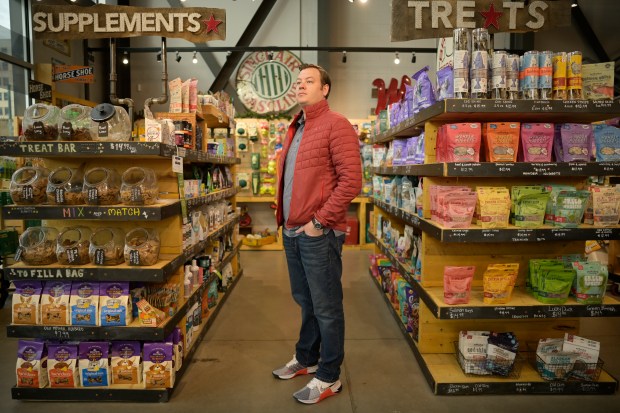How Wilding Brands hopes to reshape the craft beer industry and keep the indie brewer spirit alive
Charlie Berger, Eric Foster and Brad Lincoln aren’t naive about the headwinds facing the craft beer industry. As the founders of Denver Beer Co., Stem Ciders and Funkwerks, respectively, they’ve been in the business long enough to have witnessed its heyday circa 2015, when increasingly thirsty Americans fed double-digit growth for companies like theirs.
Fast-forward a decade, however, and the scene is much different. Gone are the days when people would line up in advance for a special beer release, and tickets to the Great American Beer Festival would sell out within hours. Gone are the days when selling $7 pints could cover a brewery’s overhead. And with Gen Z drinking less than the generations that came before it, according to industry pros, a new cohort of would-be customers is now tougher to come by.
In 2024, more craft breweries closed than opened across the nation – a first in nearly two decades. That trend has persisted across the U.S. and in Colorado, where at least 31 breweries have shuttered in 2025 alone, according to the Colorado Brewers Guild.
But Berger, Foster, and Lincoln don’t see these challenges as insurmountable. Instead, they believe this new era calls for a new way of thinking and, importantly, a new business model.
In January 2025, the three longtime friends combined their respective operations under one entity, called Wilding Brands, with the ultimate goal of keeping the spirit of independent craft breweries alive. Joining forces felt like a natural step, they said, as each company sought to adapt in the current market. They have since purchased three other major Colorado breweries, the most recent of which, Boulder’s Upslope Brewing Co., was the largest.
“We’re looking forward at the industry and how we can best continue to innovate and continue to grow and continue to produce in a profitable manner going forward,” said Foster, who serves as Wilding’s CEO.
“We realized that we could do some stuff together that we probably could not do individually,” said Berger, the company’s chief development officer.
While most of the country’s 9,000-plus breweries operate independently, partnerships are becoming more common as businesses seek to share costs on materials and real estate, maximize their production capacity, and strengthen their distribution channels, said Matt Gacioch, staff economist at the Boulder-based Brewers Association.
“Especially now, a lot of breweries that started in the mid-2010s are at this point and, over the past five years, have been at the point of lease renewal. So they’re seeing their costs associated with the properties going up substantially,” he said. “On the materials side, a lot of that has been going up while the overall economy has seen significant inflation. Certainly, brewers haven’t been immune to that.”
Options for every kind of drinker
As one of the leaders in the craft beer movement, Colorado’s scene has seen perhaps more than its fair share of collaborations in recent years.
For example, 4 Noses Brewing Co. in Broomfield was contract-brewing for hazy IPA pioneer Odd13 before buying the company in 2021. In 2023, Westbound & Down Brewing Co., which started in Idaho Springs, expanded its footprint further into the mountains by purchasing two taprooms in Aspen and Basalt. And last April, legacy beer makers Left Hand Brewing Co. in Longmont and Dry Dock Brewing Co. in Aurora merged to become a single company and pool resources.

What makes Wilding Brands unique, however, is the rate and scope of its growth strategy, which aims to reach consumers with a wide variety of products and places to drink. In its first year, the company merged its three founding brands, made several high-profile acquisitions, and built a new brewery in Arizona from the ground up.
The company started with Denver Beer Co.’s lineup of easy-drinking American beer styles, Funkwerks’ niche in Belgian-style beers and Stem’s ciders, which appeal to gluten-free and non-beer drinkers. Add in Howdy Beer, a pilsner that Stem Ciders purchased in 2022, and Wilding had a little something to offer everyone.
“The initial platform came together really quickly just because of synergies that exist kind of on the back end and production side, but also because the brands stand alone and differentiate themselves well,” Foster said.
As Wilding set out to expand, it looked for beverages and brands to further fill the gaps in its portfolio. The company shocked Denver beer drinkers when it purchased both craft stalwart Great Divide Brewing Co. in April and local staple Station 26 Brewing Co. in June. Then, in November, it scooped up Boulder-based Upslope Brewing Co., one of Colorado’s largest independent beer makers and most successful retail brands.
Beer production for all three breweries now takes place at Wilding’s so-called “Canworks” facility in the Sunnyside neighborhood, which started as a Denver Beer Co. brewery in 2014. That’s also where the company brews Funkwerks’ recipes and packages brands Howdy Beer, ¡Venga! and Easy Living Hop Water. Two of Denver Beer Co.’s taprooms still make small batches and specialty recipes onsite, but Wilding didn’t purchase Great Divide’s two Denver taprooms (which are now closed), however, or Upslope’s two Boulder locations (which will remain open). So, those locations no longer brew beer. Station 26 no longer brews its own beer either.
But Wilding did keep Station 26’s taproom with plans to maintain the vibe that has drawn a passionate well of drinkers to the Park Hill watering hole for 12 years, said Corey Dickinson, vice president of marketing. “They have a fantastic, loyal following and so it gives us an ability to continue to engage with that part of town even at local level.”

Going forward, however, Wilding has signaled it won’t rely strictly on traditional brewery and tasting room models. In November, Funkwerks closed its taproom after 15 years in Fort Collins. And Cervecería Colorado, a subsidiary of Denver Beer Co., has been reduced to a single packaged brand, ¡Venga! Mexican lager. Meanwhile, its taproom in Denver has been reimagined as a pop-up space called The Outpost on Platte, which opens solely for special events.
As for Great Divide, it boasts four full-service restaurants in Denver’s River North Arts District, Lakewood, Castle Rock and Lone Tree where the bars serve staple beers like Yeti imperial stout, as well as Stem Ciders, Funkwerks beers, cocktails and wine. Those spots — which are owned and operated by a company called Vibe Concepts, which licenses the branding — serve as opportunities to showcase Wilding’s broader selection of beverages while simultaneously creating a different kind of hospitality experience, Foster said.
“We don’t really want to make every taproom a Wilding Brands taproom. That just doesn’t make sense with how these brands have served the community over the years,” he said. For example, it’s unlikely that Denver Beer Co.’s five brick-and-mortar locations in the Mile High City, Littleton and Arvada would ever sell Great Divide beer.
“But we do look for opportunities where we can cross and where we can represent multiple brands in one location,” Foster added.

That’s true at Wilding’s two restaurants in Lafayette, Acreage and Ghost Box Pizza. Acreage, which is also the cider production facility, opened in 2018 with a massive patio and mountain views that encourage guests to stay, dine and drink awhile. Ghost Box Pizza, a concept born out of the pandemic, specializes in Detroit-style pies and has a more modest footprint that includes a dining room and arcade. Both feature a robust selection of Wilding products to drink – a model the company expects to replicate going forward.
“Beer bars-slash-restaurants that focus on all of the portfolio – we like that,” Foster said.
Beyond Colorado, Wilding moved to grow its regional presence with an original concept in Phoenix called Formation Brewing. The brewery, opened in September, brews beer onsite to pair with burgers, sandwiches and other pub fare. The bar menu also goes beyond house-made beers to include – you guessed it – Stem Ciders, Howdy Beer and Easy Living Hop Water.
“By really focusing and investing behind these brands, we can create something that hasn’t existed before in the craft bev marketplace,” Berger said. “It’s cool solutions for our accounts. It’s opportunities for employees. And we think we can do a lot with what we have, right now.”
One such opportunity came by way of Planet Bluegrass, the Lyons-based production company that throws the Telluride Bluegrass Festival, RockyGrass Festival and Rocky Mountain Folks Festival, among other events. Vice President Zach Tucker said Planet Bluegrass previously worked with Stem as a beverage provider and enlisted Wilding to stock the bars with beer, cider, seltzer and more at its 2025 and 2026 events.
“They cover most of our drink offerings with beer/seltzer/cider/NA,” Tucker said by email. “Our festivarians were very receptive to all their offerings, including their non-alcoholic options this year. We are excited to work with them again as they are great teammates in putting the events together, our companies align in our sustainability efforts, we love that they are local to Colorado, and we both believe in the value of bringing people together around shared experiences.”
This kind of partnership would be difficult to pull off for just one brewery, Dickinson said. “But by coming together, we have access to not only more resources but we have a better opportunity to provide a better experience at an event like that – where we can say, ‘here’s a selection of amazing products coming from one place’ but (it) gives the consumer better choice.”
Unsurprisingly, the Wilding team plans to introduce new products to meet evolving consumer tastes. Stem recently released its first non-alcoholic cider in hopes of catching Dry January buzz.

Are craft conglomerates different?
With its recent flurry of deals, Wilding has brought mergers and acquisitions back into the beer industry spotlight. A decade ago, it was commonplace to hear about conglomerates like Anheuser Busch-InBev and Molson Coors purchasing craft breweries to tap into market share, but as consumer tastes have changed, some of those companies are reversing course.
Just last year, Molson Coors sold its craft portfolio and discontinued its experimental arm, AC Golden Brewing Co., effectively exiting the craft market to invest in more lucrative endeavors. AB InBev, meanwhile, unloaded Breckenridge Brewery and other formerly independent beer makers that it had purchased.
Foster maintains that Wilding Brands is inherently different from players in the previous era of M&A. “We really are a founder-led craft beer platform,” he said — one that has quietly become one of the Centennial State’s largest alcoholic beverage producers.
Lincoln said its current annual output exceeds 80,000 barrels, making Wilding now Colorado’s third-largest craft brewer, behind only Odell Brewing Co. and Monster Brewing Co., according to the Brewers Association — and that’s before you add in the 7,200 barrels of cider it is on track to make in 2025.
“As you look at what craft was versus what craft is today, it’s a completely different environment with completely different scales of budgets and available capital to do some of these things,” Foster said. “So clearly as we come together and form a larger entity, we’re stronger in that regard. We have a better balance sheet, we have bigger budgets to do some of these things and better compete with the now-macro-back-to-craft companies out there.”
Gacioch at the Brewers Association, too, thinks these types of partnerships will bolster the industry because the craft ethos remains core to the business. The teams selling the beer understand the market and vernacular, for one, and aren’t also promoting the country’s most popular light lagers, he said.
“These are reasons to think this kind of consolidation we’re seeing recently is going to raise all boats, whereas the M&A that we saw maybe 10 years ago was more of ‘purchase this, see how it goes and stick with it or divest.’ It wasn’t central to the success of the acquiring business itself,” Gacioch said.
With all that transpired over the last year, Wilding Brands is taking time to integrate the companies and teams that it brought together, Berger said. The company employs more than 400 people who used to be competitors and now need to leverage their experience toward a common vision.
But one thing is for sure, Wilding isn’t done yet. “The phone is ringing,” Berger said.








